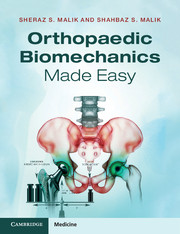Book contents
- Frontmatter
- Dedication
- Contents
- Contributors
- Epigraph
- Preface
- Acknowledgements
- Part I Orthopaedic biomaterials and their properties
- Part II Engineering theory applied to orthopaedics
- Part III Clinical biomechanics
- 6 Biomechanics of the hip and total hip replacement
- 7 Biomechanics of the knee and total knee replacement
- 8 Biomechanics of the shoulder
- 9 Biomechanics of the elbow
- 10 Biomechanics of the spine
- 11 Biomechanics of the ankle and foot
- 12 Biomechanics of fracture fixation
- 13 Trauma meeting: case-based discussions
- Index
10 - Biomechanics of the spine
from Part III - Clinical biomechanics
Published online by Cambridge University Press: 05 June 2015
- Frontmatter
- Dedication
- Contents
- Contributors
- Epigraph
- Preface
- Acknowledgements
- Part I Orthopaedic biomaterials and their properties
- Part II Engineering theory applied to orthopaedics
- Part III Clinical biomechanics
- 6 Biomechanics of the hip and total hip replacement
- 7 Biomechanics of the knee and total knee replacement
- 8 Biomechanics of the shoulder
- 9 Biomechanics of the elbow
- 10 Biomechanics of the spine
- 11 Biomechanics of the ankle and foot
- 12 Biomechanics of fracture fixation
- 13 Trauma meeting: case-based discussions
- Index
Summary
Biomechanics of spinal components I
The spinal column is designed to carry loads and provide a wide range of movements, whilst also protecting the spinal cord and the related neurovascular structures.
The vertebrae provide stiffness to the spinal column.
Vertebrae
A typical vertebra has the following common key features: vertebral body, facet (intervertebral) joints, and spinous and transverse processes.
Vertebral body
The vertebral body is the main load-bearing part of the vertebra. It is designed to support mainly compressive loads, which are produced by the weight of the body above the vertebra. A typical vertebral body has the shape of a short cylinder. It has a thin shell of cortical bone surrounding a core of porous cancellous bone. The cancellous bone is organised into vertical and horizontal trabaculae, which is the most effective arrangement to resist compressive force. The compressive force is resisted mainly by the vertical ‘columns’, and the horizontal ‘cross-beams’ prevent the columns from bowing under stress. This arrangement of cancellous bone converts an axial compressive force into a transverse tensile force. The fact that vertebrae are not solidly filled with bone is also mechanically important. Solid vertebrae would be significantly heavier and less effective at withstanding dynamic loads. This is because solid structures are less ‘springy’ and provide less ‘cushion’ when loaded suddenly (hence the reason why empty cardboard boxes can be used to cushion a person falling from a height). The porous cancellous bone enables the vertebrae to be lightweight and still be adequately stiff and strong to withstand different types of loads.
- Type
- Chapter
- Information
- Orthopaedic Biomechanics Made Easy , pp. 142 - 149Publisher: Cambridge University PressPrint publication year: 2015



